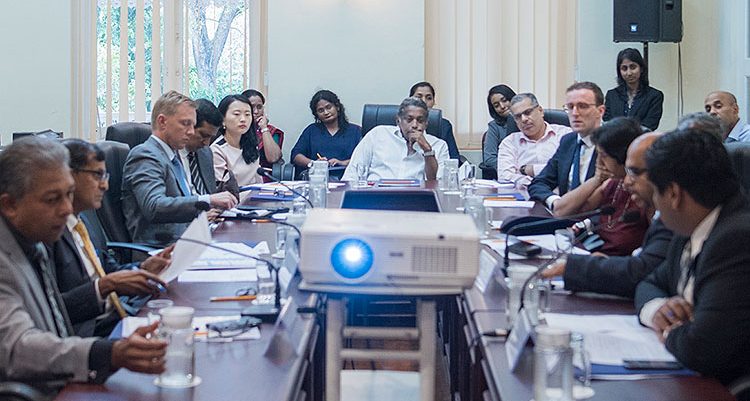Takeaways – Admiral (Retd.) Travis Sinniah and Dr. Harinda Vidanage on ‘The Asian Arms Race, Geopolitics and Possible Implications for Sri Lanka’
March 25, 2019 Reading Time: 3 minutes

Reading Time: 3 min read
Three key takeaways from the round table discussion with Admiral (Retd.) Travis Sinniah and Dr. Harinda Vidanage –
- States will continue to use military capacity to increase their influence, and arms races are an outcome of such behaviour linked to advances in warfare and industrial innovation.
- The absence of bilateral and multilateral arms control agreements and its many unresolved political issues have made South Asia the most at-risk region in the world for a potential nuclear conflict.
- Sri Lanka, as a smaller state, could aim to build up its capacity to act as a neutral venue for more regional dialogue to advance regional stability and security.
Introduction
- Admiral Travis Sinniah, former Commander of the Sri Lanka Navy; and Dr. Harinda Vidanage, Executive Director of the Bandaranaike Centre for International Studies (BCIS); addressed a Foreign Policy Round Table on ‘The Asian Arms Race, Geopolitics and Possible Implications for Sri Lanka’ on 11 March 2019 at the Lakshman Kadirgamar Institute (LKI).
- The round table discussion was moderated by Dr. Ganeshan Wignaraja, Executive Director, LKI. Mr. Malinda Meegoda, Research Associate of LKI’s Global Governance Programme was a discussant.
- The round table was attended by Mr. Ravinatha P. Aryasinha, Secretary to the Ministry of Foreign Affairs, other government officials, military officials, private sector representatives, and diplomats.
Takeaways from Admiral Travis Sinniah’s Presentation:
Revolution in Military Affairs
- Early to mid twentieth-century warfare was notable for the use of sea power and air power on the battlefield that culminated in the use of the atomic bomb in 1945.
- The Cold War period contributed to a new bilateral arms race between the US and the Soviet Union and introduced concepts such as Mutually Assured Destruction (MAD).
- States with the most powerful militaries in the world are moving away from notable arms control agreements such as the Intermediate-Range Nuclear Forces Treaty (INF), and are in a race to develop other weapons systems such as Lethal Autonomous Weapons Systems (LAWS).
Complexities in the South Asian Arms Race
- Unresolved border issues and lack of bilateral policies in the use or limitation of nuclear weapons can lead to conflicts and crises that could move up the nuclear escalation ladder.
- The disparity in comparative conventional military strength prevented some actors from giving up their nuclear option, particularly on the first use of a nuclear weapon.
- The deployment of tactical nuclear weapons (TNW) as potential battlefield weapons with their small size, vulnerability to theft, and perceived usability make the existence of TNWs in national arsenals a risk to regional and global security.
Challenge for Sri Lanka
- Sri Lanka’s socio-economic and military ties with the regional nuclear weapons states, and Sri Lanka’s geostrategic position in the Indian Ocean could challenge Sri Lanka’s existing norms on neutrality.
- Being an island gives Sri Lanka a natural defensive boundary that shields its territorial integrity. Nonetheless, the state must consider contingencies to deal with any nuclear mishaps such as from an India-Pakistan conflict or an accident involving a submarine or naval ship in Sri Lankan waters.
Takeaways from Dr. Harinda Vidanage and Mr. Malinda Meegoda’s Presentations:
Militarisation and its Effects on State Behavior
- Militarisation, due to an arms race, often results in the loss of credibility in the states’ ability to engage in cooperative diplomatic efforts.
- As militarisation promotes a state of permanent adversarial posturing, smaller states can become trapped between regional powers and may be compelled to choose sides.
- The militarised Indian Ocean is an opportunity for Sri Lanka to increase its political neutrality and promote dialogue, particularly within South Asia. To do this successfully, Sri Lanka must aim to resolve its internal political challenges.
Sri Lanka’s Security and Resource Reallocation Strategy
- Sri Lanka, as a small state, operating in a tight fiscal environment needs to come up with strategies to increase the optimum use of its military resources.
- Sri Lanka could look at reducing the number of active duty troops and increasing its reservists.
- Investing in a long-term strategic transformational plan includes; periodic defence reviews, and greater integration of research institutes to develop Sri Lanka’s military capabilities.
Takeaways from the Discussion:
- A concentration of India’s strike capabilities in South India poses a threat to Sri Lanka, which highlights the need to implement a contingency strategy in case of nuclear fallout.
- The Sri Lankan Navy lacks adequate surveillance capabilities to monitor Sri Lanka’s underwater dimensions and could look to invest in anti-submarine vessels that can detect potential threats underwater.
- Smaller states like Sri Lanka can be vulnerable to third country interferences in the cyber realm, and the weaponisation of social media in Sri Lanka could undermine public opinion on the local political system.
- Sri Lanka could invest more in human capital and develop its cyber capabilities.
Suggested Readings:
Meegoda, M. (2018). How can Sri Lanka Navigate the Asian Arms Race Conundrum? Lakshman Kadirgamar Institute. [Online] Available at: https://lki.lk/publication/how-can-sri-lanka-navigate-the-asian-arms-race-conundrum/ [Accessed 20 March 2019].
Hoodbhoy, P. and Mian, Z. (2018). Managing Pakistan’s Bomb: Learning on the Job. Bulletin of Atomic Scientists. [Online] Available at: https://thebulletin.org/2018/08/managing-pakistans-bomb-learning-on-the-job/ [Accessed 20 March 2019].
Waidyatilake, B. (2018). Sri Lanka’s Strategy for Regional Security. [Online] The Diplomat. Available at: https://thediplomat.com/2018/07/sri-lankas-strategy-for-regional-security [Accessed 20 March 2019].
Meegoda, M. (2018). Revisiting Nuclear Weapon Free Zones in South Asia: Evaluating Policy Options for Smaller States. Lakshman Kadirgamar Institute. [Online] Available at: https://lki.lk/blog/revisiting-nuclear-weapon-free-zones-in-south-asia-evaluating-policy-options-for-smaller-states/ [Accessed 20 March 2019].
Photos: Fluke by Ruvin de Silva
